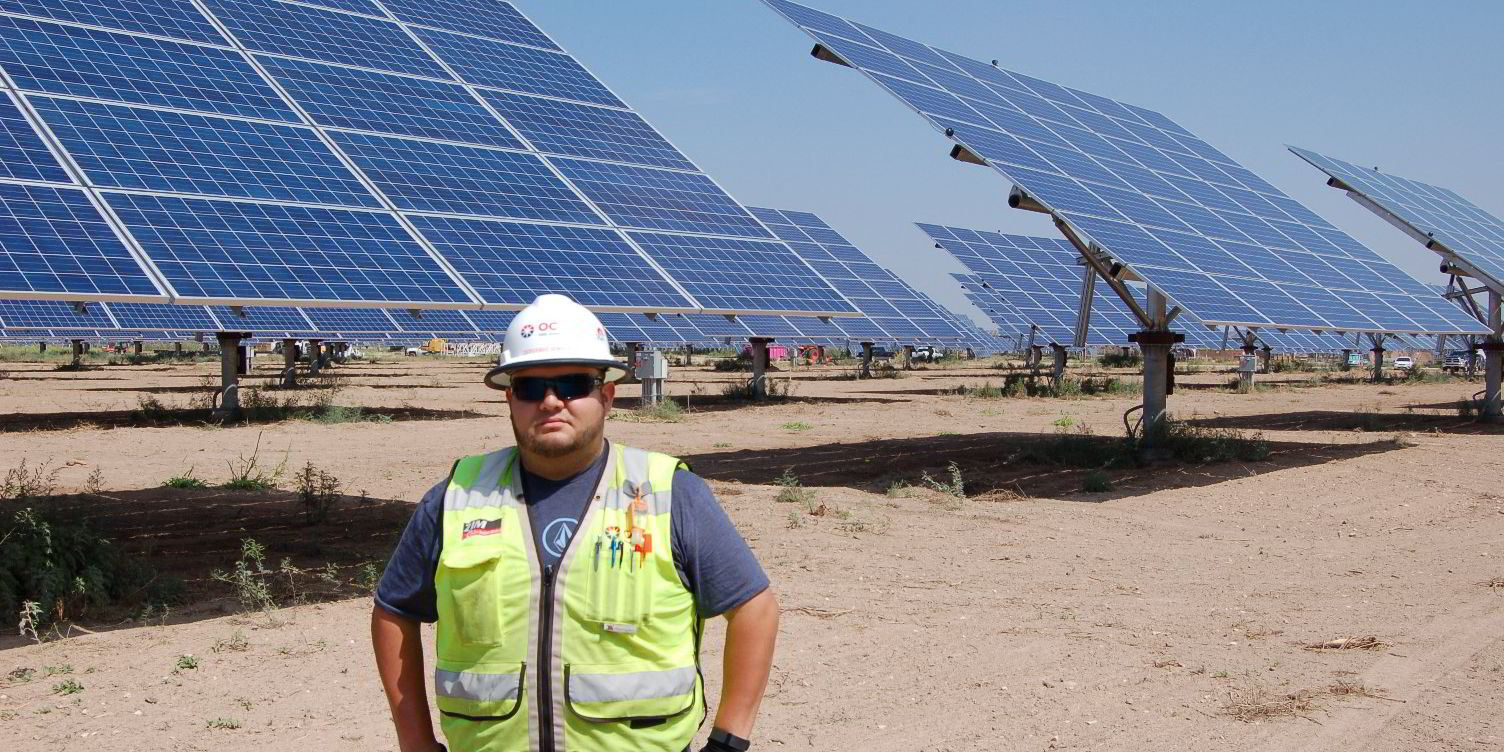It’s now between 80% and 90% done, construction manager James Allen of OCI, which is the developer, owner and future operator of Alamo 6, tells Recharge.
Alamo 6 is a testament to both how far OCI has advanced to become an important player in US utility-scale solar development and the emergence of Texas as a magnet for global investors who view big solar in the state as having tremendous growth potential.
About 250 workers are now busy here, 40% of them from an oil and gas industry in recession, down from a peak of 375. The facility is located on private land that OCI has under lease.
Even so, it remains a beehive of activity with Allen and his leadership team making sure that construction deadlines are rigorously met.
This requires close coordination and planning with Mortenson, serving as the full-service EPC contractor. Alamo 6 is the fourth utility-scale PV project it has built for OCI in Texas and the 35th overall in the US.
OCI and Mortenson take great care to ensure that all work and movement of personnel occurs safely. Workers and visitors need to stay alert amid moving heavy machinery, large trucks delivering components and supplies, and those spreading water along dirt roads at the jobsite in an effort to tamp down the swirl of dust from each passing vehicle.
The unforgiving Chihuahuan Desert also serves up an unhealthy menu of biting insects, snakes and spiders to contend with, not to mention a burning sun and the ever-present danger of dehydration. OCI closely monitors the weather as rapidly moving late afternoon storms can generate potentially dangerous lightning and occasional hailstones.
Looking at the project’s scale and progress across about 1,200 acres (4.9sq km), it’s hard to believe that so much has been accomplished since work began in May 2015. Even more so considering the logistics involved in supplying such a remote jobsite where red-headed turkey vultures and road runner cuckoo birds appear to outnumber humans along roads to the few hamlets located within reasonable driving distance.
OCI and Mortenson established "man camps" nearby to house some workers, while others choose to commute to rental rooms, apartments and hotels in Fort Stockton, 47 miles distant, and a few other smaller communities.
"You see RV camps that are filling up – most that have been occupied by oilfield workers maybe during the downfall emptied out, Right now they are packed again with solar workers. It’s hard to find a spot anywhere around here," says Servando Sendejo III, an OCI quality control associate at Alamo 6.
No one is complaining. Solar jobs pay well in a resource-rich region hard hit by the slowdown in oil and gas. More than 100,000 upstream jobs have been lost in the state since December 2014, according to the Texas Petro Index.
The project is located about halfway between San Antonio and El Paso, but don’t expect to see it from Interstate 10, the main east-west highway linking those cities. It requires a lonely drive through arid countryside sprinkled with low-level vegetation whose names caution a visitor that this land is largely inhospitable: creosote bush, prickly pear cactus, shin dagger, soaptree yucca and tarbush.
Alamo 6 is within the limits of Bakersfield, population 50 - at least that's what the census reads. Traveling east on Ranch Road 1901,the project is hard to see from a distance at ground level until it suddenly looms off the desert floor as far as the eye can see. The giant trackers - each one weighing upwards of five tons with 42 modules – are pointed at the late morning sun in perfectly aligned rows, dwarfing nearby vehicles and workers.
Staring down at the metallic newcomers are hundreds of wind turbines, many idle in the still midday air, atop distant mesas, the flat-topped hills that dot the landscape. Allen says that Alamo 6 will have 10,440 of the trackers, which move east to west – he calls it azimuth – and also elevation-wide north and south.
OCI is using modules assembled at a new plant in San Antonio by sister company Mission Solar Energy. It also has a 60% holding in Sun Action Trackers, which is supplying the dual-axis trackers. Kaco New Energy, also located in San Antonio, is providing the inverters.
Those facilities emerged as part of a trailblazing 400MW solar power supply deal between OCI and San Antonio municipal utility CPS Energy in 2012 that have brought hundreds of jobs to that metropolitan area. The utility since signed for an additional 50MW, a project under construction adjacent to Alamo 6 that OCI calls Pearl. It will be in operation next year.
The original deal propelled then little-known OCI Solar Power, part of OCI, a large South Korean chemicals company, into the US market. Five of seven subsequent PV projects are in operation in Texas, leaving Alamo 6 and the 106MW (ac) Alamo 7 north of Abilene - also with a late 2016 completion date.
To export power from Alamo 6, OCI had to construct a new electrical switchyard that steps up power generated from there to 138kV that regional utility Lower Colorado River Authority will feed into long-distance 345kV transmission lines.
Allen says it will require at least 60 days to fully commission Alamo 6 and a team of between four and eight people to operate and maintain it.
Last October, main state grid operator Electric Reliability Council of Texas forecast that between 10GW and 13GW of new solar capacity will be added to its system by 2029.
OCI and its San Antonio-based suppliers would appear well-positioned for future growth even if not all of that capacity comes to pass..

